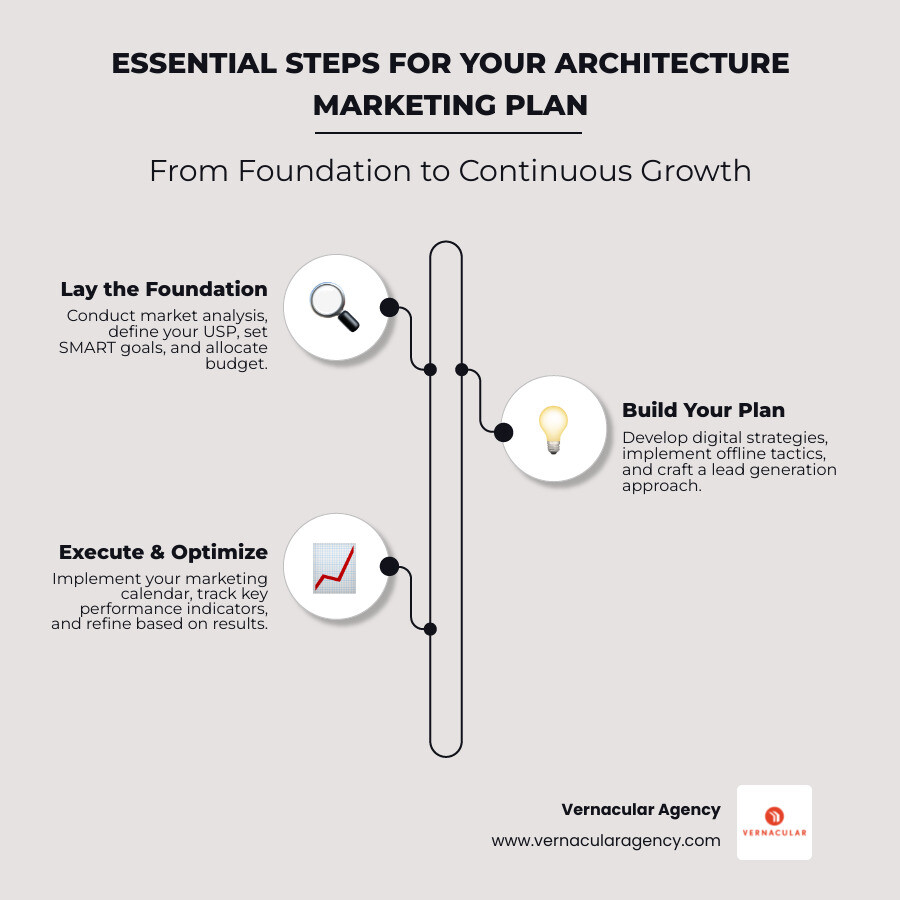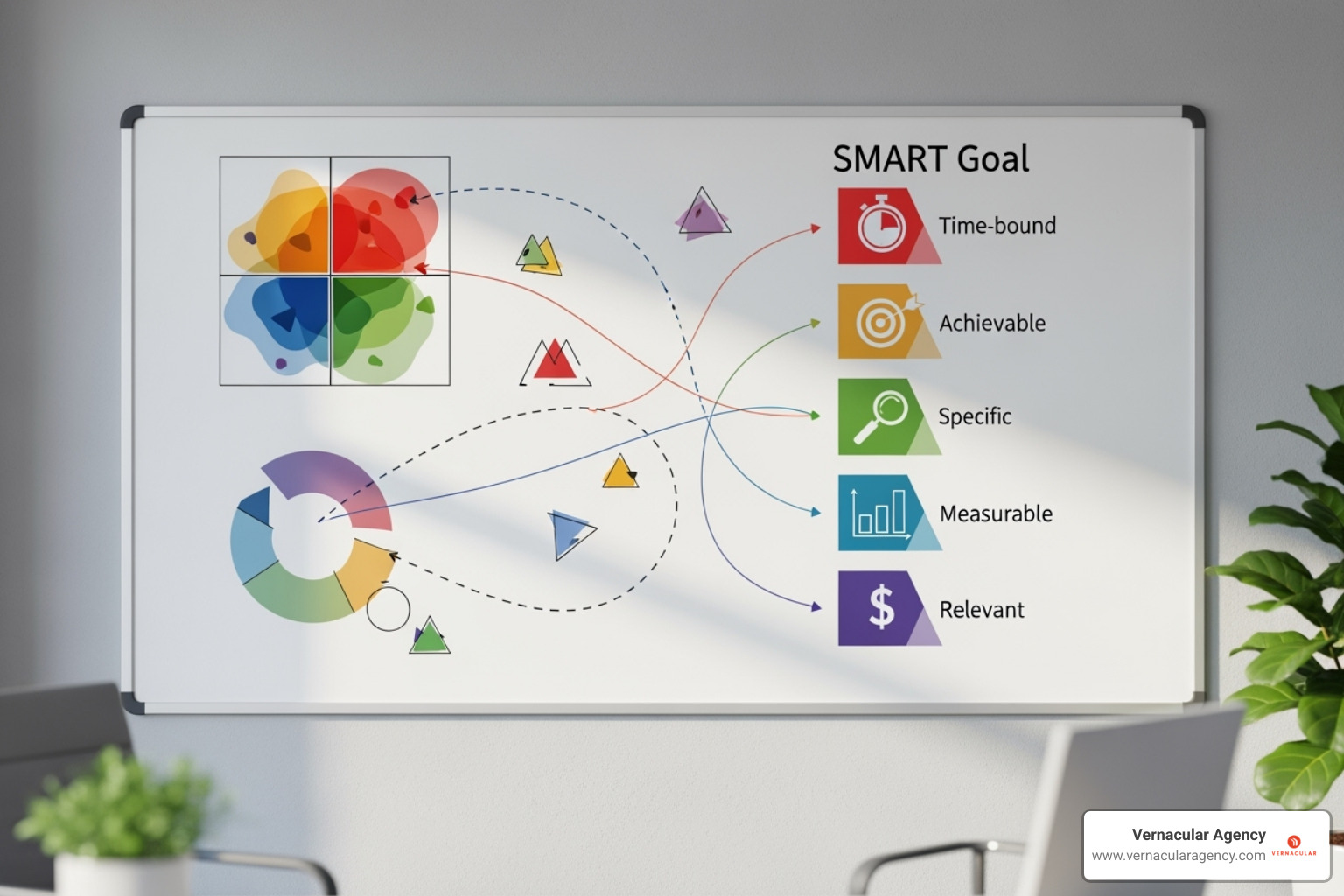A marketing plan for architecture firm success is no longer optional. In today's competitive landscape, the days of relying solely on word-of-mouth referrals are over, whether you're a solo practitioner or leading a growing firm.
Quick Answer: Essential Components of an Architecture Firm Marketing Plan
The research is clear: firms grow 30% faster when they have a strategic plan, and people who are organized with marketing are 674% more likely to be successful. Yet many architects find themselves trapped in the feast-or-famine cycle, taking on ill-fitting projects just to pay the bills while their ideal clients search for services online.
The shift from passive to proactive marketing isn't just about survival—it's about building the practice you've always envisioned. When 84% of AEC clients visit your website before considering a call, your digital presence becomes your most important business development tool.
I'm Rebecca Falzano, and with nearly 15 years of experience as a creative director and content strategist, I've helped countless firms develop an effective marketing plan for architecture firm growth. Through my work guiding content creation and brand development, I've seen how the right marketing approach can lift a firm from competing on price to commanding premium fees for exceptional work.

Marketing plan for architecture firm terms to know:

Think of this phase as your marketing blueprint. Just as you wouldn't start construction without detailed drawings, every successful marketing plan for architecture firm needs a solid foundation built on strategic analysis, clear goals, and smart budgeting. This foundational work is what separates firms that see real growth from those that throw marketing dollars at the wall hoping something sticks. A well-crafted Marketing Strategy transforms scattered efforts into a client-attracting system.
Before you can attract your ideal clients, you need to know who they are and what makes your firm the perfect fit. This starts with an honest SWOT Analysis.
Your strengths might be a stunning portfolio or your team's communication skills. Weaknesses could be an outdated website or a lack of case studies. Opportunities might include a growing demand for sustainable design, while threats could be new, aggressively priced firms entering your market.
This analysis helps define your ideal client profile. Analyze your best past projects: what did those clients have in common? Understanding their motivations and challenges helps you speak their language in all your marketing.
Many firms make the mistake of trying to be everything to everyone. Niche specialization is often the fastest path to premium fees and less competition. When you become known as "the architect for historic building changes," clients seek you out.
Competitor research isn't about copying others; it's about finding gaps you can fill. Perhaps their websites are beautiful but not user-friendly, or their messaging is generic. These gaps are your opportunities to stand out.
Your Unique Selling Proposition emerges from this analysis. What makes working with you different? Maybe it's your collaborative process or your expertise in local building codes. This becomes the foundation of your Brand Identity and guides every marketing decision.
Vague goals like "get more clients" lead to vague results. Your marketing plan for architecture firm success needs goals that are specific, measurable, attainable, relevant, and time-bound.
Set concrete goals like "increase website inquiries by 30% in six months" or "secure two new commercial projects by year-end."
Effective marketing is an investment that pays for itself when done right. While some businesses spend 3-5% of their revenue on marketing, growing firms often invest 7-10% to fuel expansion. If you're launching into new markets or services, you might need to invest more initially.
Budget allocation should follow your goals. If your goal is digital lead generation, invest in your website, SEO, and content. If networking drives your best clients, budget for industry events and relationship-building.
The key is tracking ROI. Digital marketing offers clear metrics, allowing you to see how many website visitors become inquiries and then clients. This data helps you double down on what works. The most expensive marketing is marketing that doesn't work. A planned budget is far less costly than years of scattered, ineffective efforts.

Now it's time to construct the strategies that will attract and convert clients. This is where your Digital Marketing efforts become essential business tools, moving your plan from schematic design to design development.
Most architecture firms focus their marketing on the tiny percentage of people ready to hire right now. The Client Demand Pyramid reveals a hidden truth: at any given moment, only about 3% of potential clients are actively ready to hire an architecture firm.
The golden opportunity most firms miss is the 91% of potential clients in the information-gathering phase. They're browsing websites and reading articles, trying to understand what working with an architect involves. Traditional marketing fails because it only speaks to the 3% at the top.
When you create content for the massive 91%—the people just beginning their journey—you build trust and establish expertise long before they're ready to buy. You become the firm they remember when they are ready to move forward. This approach transforms the feast-or-famine cycle into a predictable pipeline of qualified leads.
The digital marketing world is a booming industry. A strong digital presence can increase brand awareness by up to 86% and boost credibility by 75%. Successful marketing isn't about choosing between digital and offline; it's about creating an integrated approach where everything works together, maintaining brand consistency across all touchpoints.
Your marketing plan for architecture firm growth should blend digital and offline tactics. Digital strategies like your website, SEO, and content marketing work 24/7 to attract and educate potential clients. Meanwhile, offline engagement through networking and speaking builds crucial personal connections.
Your digital presence is your most powerful business development tool, as 84% of AEC clients visit your website before they'll consider a call.
Face-to-face connection remains powerful. Networking events, whether industry conferences or local business gatherings, build the personal relationships that drive business. Public speaking positions you as a thought leader and demonstrates your expertise to a room of potential clients. Industry awards and community involvement build your reputation and provide excellent marketing material. Strategic partnerships with complementary businesses like designers and contractors can create high-quality referral streams. Finally, even your well-crafted proposals are marketing tools that showcase your professionalism.
This strategy flips traditional marketing on its head. A sailor can't throw a heavy rope to shore, so they throw a lighter line with a weighted knot—a "monkey's fist"—and use it to pull the heavy rope over.
In marketing, your "monkey's fist" is a low-commitment, high-value offer that attracts potential clients. Instead of leading with "hire me," you lead with "let me help you." This value-first marketing targets the 91% of clients in the information-gathering phase. You might offer an e-book, a checklist, or a webinar.
The goal is to build trust and demonstrate expertise. When someone downloads your guide, they're raising their hand. You can then nurture that relationship through educational content until they're ready to hire. This approach has been shown to return results 500% greater than traditional marketing because it systematically builds an email list of qualified, engaged leads.

Marketing plans are only as good as their execution. The real change happens when we bring these plans to life. This phase is about moving from blueprints to breaking ground: consistent implementation, smart performance tracking, and a willingness to adjust course based on data.
Modern marketing is measurable. Unlike the old days of placing an ad and hoping for the best, today we can track almost everything. Our SEO Website Optimization Management services exemplify this approach—we continuously monitor, analyze, and refine to ensure your investment delivers real results.
The gap between a great plan and great results is consistent execution. Start with a detailed marketing calendar that maps out every activity for the next quarter, including blog deadlines, email schedules, and networking events.
Clear task assignment is critical. When everyone knows their role, your marketing machine runs smoothly. Project management tools are invaluable for keeping teams organized, allowing you to assign tasks and track progress at a glance.
Team buy-in is also crucial. When your entire team understands how marketing supports the firm's growth, they become active participants. Finally, be realistic about resource allocation. It's better to do fewer things well than many things poorly.
Remember those SMART goals? KPIs tell you if you're hitting them. Track these key metrics to measure the success of your marketing efforts:
This is the continuous improvement cycle. The data doesn't lie, but it requires interpretation. If a blog post on sustainable materials gets twice the usual traffic, your audience is telling you what they want to read.
A/B testing is your secret weapon. Test different email subject lines or contact forms to see what performs better. These small experiments can lead to significant improvements.
Google Analytics provides a wealth of insights about your website visitors, helping you identify what's working and what needs improvement.
Your marketing plan for architecture firm success must be a living document. Market conditions change, client preferences evolve, and new platforms emerge. Adapt accordingly.
When should you seek professional marketing assistance? If you're putting in the effort but not seeing results, lack the time to implement your plan, or simply want to accelerate growth, it might be time to bring in experts. The goal isn't perfection from day one—it's consistent improvement over time.
Traditional marketing, like relying solely on referrals, is a passive approach. It fails because it narrowly targets only the small percentage of clients (the 3% at the top of the Client Demand Pyramid) who are ready to hire immediately.
This approach misses the vast majority of the market—the 91% who are in the crucial information-gathering phase. Traditional methods don't engage clients early, build trust, or establish a firm's authority. In today's digital-first world, where clients do extensive online research, a passive approach is no longer enough to stand out or create a predictable lead pipeline.
Building brand awareness requires a proactive, strategic approach. Here's how we advise our clients:
Combining these strategies can significantly increase brand awareness, with a robust digital marketing strategy potentially boosting it by up to 86%.
A strong marketing plan for architecture firm growth changes your business development from a reactive, unpredictable process into a proactive, strategic one.
Here’s how:
A marketing plan empowers you to take control of your firm's growth, ensuring you're always attracting the right clients and projects.
A comprehensive marketing plan for architecture firm success is more than a checklist item; it's the blueprint for your ideal practice. We've covered the essential steps: from foundational analysis and goal-setting to digital and offline strategies, and finally, to implementation and optimization.
The architectural landscape has fundamentally shifted. While exceptional design remains the heart of what you do, it's no longer enough to simply wait for clients to find you. Today's successful firms understand that proactive marketing beats reactive hoping every time.
Think of your marketing plan as you would any architectural project. The firms that accept this mindset—those that understand the Client Demand Pyramid, invest in both digital and offline relationships, and consistently measure and optimize—are the ones thriving in today's market.
Your marketing plan is a living document. Just as buildings require maintenance, your strategy needs regular attention. The key is staying flexible while maintaining focus on your core goals and ideal clients.
The change from feast-or-famine to predictable growth doesn't happen overnight. Every blog post you publish, every networking event you attend, and every optimization you make builds toward a more sustainable future for your firm.
At Vernacular Agency, we've seen how the right marketing approach can transform an architecture practice. We help firms translate their unique vision into a powerful brand and marketing strategy that doesn't just attract clients—it attracts the right clients. The ones who value great design and are willing to invest in exceptional architecture.
Your firm's story deserves to be told well. Your expertise deserves to be recognized. Your ideal clients are out there, searching for exactly what you offer.
Ready to build something extraordinary? Explore our services to build your winning plan and let's create a marketing strategy as thoughtful and impactful as your architecture.